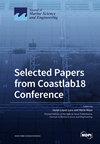Thermodynamic and Economic Analysis of Cargo Boil-Off Gas Re-Liquefaction Systems for Ammonia-Fueled LCO2 Carriers
IF 2.8
3区 地球科学
Q1 ENGINEERING, MARINE
引用次数: 0
Abstract
In this study, cargo boil-off gas (BOG) re-liquefaction systems for ammonia-fueled liquefied carbon dioxide (LCO2) carriers were analyzed. These systems use cold energy from ammonia to reliquefy the CO2 BOG. In this study, a system that can completely reliquefy the CO2 BOG at all engine loads using only one heat exchanger is proposed, instead of the existing cascade system that requires multiple components. R744, which has a low global warming potential, was used as the working fluid for the refrigeration cycle in the CO2 BOG re-liquefaction system. The organic Rankine cycle (ORC) was used to reduce the net power consumption of the system. The existing and proposed systems were classified into Case 1 (existing system), Case 2 (our proposed system), and Case 3 (Case 2 combined with an ORC). Thermodynamic and economic analyses were conducted. Case 2 is a system with a simpler configuration than Case 1, but it has a similar thermodynamic performance. Case 3 has a higher exergy destruction rate than Cases 1 and 2, owing to the ORC, but it can significantly reduce the net power consumption. The economic analysis shows that Cases 2 and 3 reduce the total annual costs by 17.4% and 20.1%, respectively, compared to Case 1. The proposed systems are significantly more advantageous for long-term operation than existing systems.氨燃料液化二氧化碳运输船货物沸腾气体再液化系统的热力学和经济分析
本研究分析了以氨为燃料的液化二氧化碳(LCO2)运输船的货物沸腾气(BOG)再液化系统。这些系统使用氨的冷能来重新液化二氧化碳 BOG。本研究提出了一种仅使用一个热交换器就能在所有发动机负荷下完全再液化 CO2 BOG 的系统,而不是现有的需要多个组件的级联系统。二氧化碳 BOG 再液化系统中的制冷循环使用了全球变暖潜能值较低的 R744 作为工作流体。有机郎肯循环 (ORC) 用于降低系统的净功耗。现有系统和建议的系统被分为情况 1(现有系统)、情况 2(我们建议的系统)和情况 3(情况 2 与 ORC 相结合)。进行了热力学和经济学分析。案例 2 是一种配置比案例 1 简单的系统,但热力学性能相似。由于采用了 ORC,案例 3 的放能破坏率高于案例 1 和 2,但可以显著降低净耗电量。经济分析表明,与方案 1 相比,方案 2 和方案 3 的年总成本分别降低了 17.4% 和 20.1%。与现有系统相比,拟议系统的长期运行优势明显。
本文章由计算机程序翻译,如有差异,请以英文原文为准。
求助全文
约1分钟内获得全文
求助全文
来源期刊

Journal of Marine Science and Engineering
Engineering-Ocean Engineering
CiteScore
4.40
自引率
20.70%
发文量
1640
审稿时长
18.09 days
期刊介绍:
Journal of Marine Science and Engineering (JMSE; ISSN 2077-1312) is an international, peer-reviewed open access journal which provides an advanced forum for studies related to marine science and engineering. It publishes reviews, research papers and communications. Our aim is to encourage scientists to publish their experimental and theoretical results in as much detail as possible. There is no restriction on the length of the papers. The full experimental details must be provided so that the results can be reproduced. Electronic files and software regarding the full details of the calculation or experimental procedure, if unable to be published in a normal way, can be deposited as supplementary electronic material.
 求助内容:
求助内容: 应助结果提醒方式:
应助结果提醒方式:


